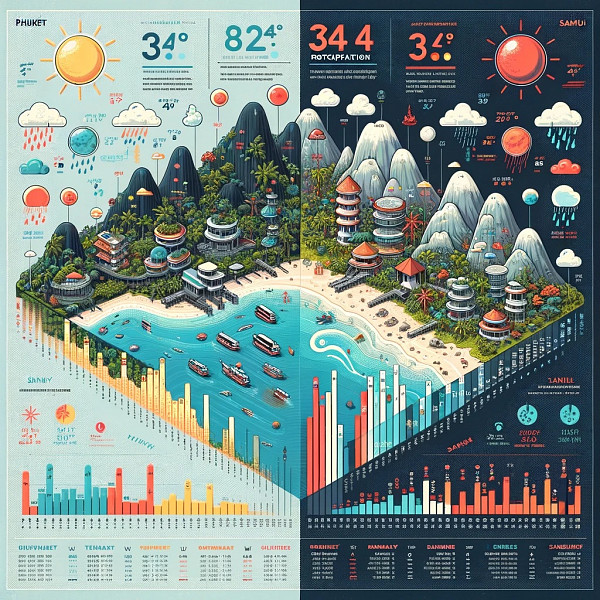
Nestled in the azure waters of Thailand, Phuket and Samui are jewels of the Andaman Sea and the Gulf of Thailand, respectively. Each island boasts its unique charm, attracting millions of visitors yearly with their pristine beaches, vibrant nightlife, and lush landscapes. However, beyond their apparent similarities, Phuket and Samui exhibit distinct climatic patterns that could significantly impact your holiday experience. This post delves into the differences in climate between Phuket and Samui, shedding light on why understanding these variations is crucial for planning your visit.
The Tale of Two Seas: Phuket vs. Samui Climate Overview
Geographical Orientation and Seasonal Shifts:
Phuket: Located in the Andaman Sea, Phuket experiences a tropical monsoon climate. The island has a pronounced rainy season from May to October, with September being the wettest month. The dry season spans from November to April, featuring warmer temperatures and minimal rainfall, making it an ideal time for tourists.
Samui: Situated in the Gulf of Thailand, Samui's climate slightly deviates from Phuket's. Its rainy season is shorter, typically from late October to December, with November seeing the highest rainfall. The dry season extends from January to September, offering a longer period of sunny, pleasant weather, which is particularly appealing to sun-seekers.
Why the Difference?
Influence of Geographical Location: The primary factor contributing to the climatic differences between Phuket and Samui is their geographical positioning relative to the Thai peninsula. Phuket faces the Andaman Sea in the Indian Ocean, while Samui is nestled in the Gulf of Thailand. This distinction results in varying exposure to monsoonal winds and rain-bearing systems, influencing each island's specific rainy and dry seasons.
Monsoonal Effects:
Phuket: The southwest monsoon, which brings moist air from the Indian Ocean, heavily influences Phuket's weather, resulting in significant rainfall during the rainy season.
Samui: Conversely, Samui is somewhat sheltered from the direct impact of the southwest monsoon by the mainland. However, it is affected by the northeast monsoon, which brings drier air from the Asian continent, contributing to its distinct rainy season towards the end of the year.
Planning Your Visit: What Does This Mean for Travelers?
Understanding the climatic nuances between Phuket and Samui can greatly enhance your travel experience by allowing you to choose a destination that aligns with your weather preferences. For those looking to escape the cold winters of the Northern Hemisphere, both islands offer warm, inviting climates, but the timing of your visit could be pivotal.
Visit Phuket during its dry season (November to April) to enjoy outdoor activities like snorkeling, diving, and beach-hopping without the interruption of heavy rains.
Head to Samui if you prefer traveling in the earlier part of the year (January to September), taking advantage of its extended dry season for clear skies and sunny days.
Conclusion
Phuket and Samui, each with its distinct climate, offer diverse experiences to their visitors. Whether you're drawn to the lush, rainy landscapes of Phuket's monsoon season or the prolonged sunny days in Samui, understanding these differences empowers you to make informed decisions about your travel itinerary. By choosing the right island and the right time, you can ensure that your Thai island adventure is everything you've dreamed of, with weather conditions that perfectly match your holiday expectations.





